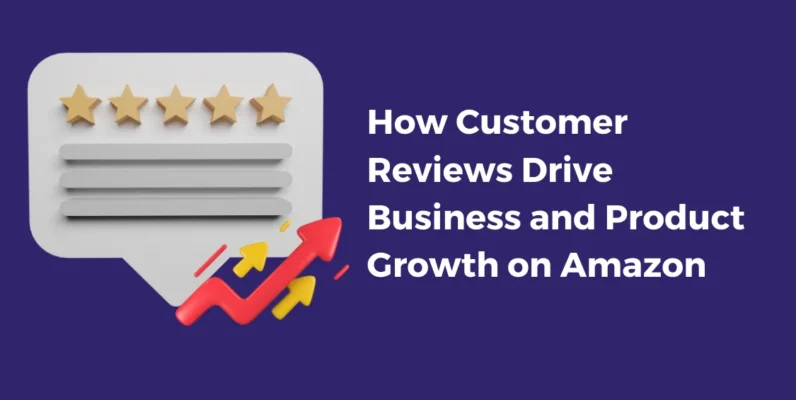Key Takeaways
- AMC goes beyond surface-level reporting. Unlike Ads Console or DSP reports, AMC shows how ads influence shopper journeys across multiple touchpoints, not just last-click conversions.
- It’s now accessible to more advertisers. With 2025 updates, Sponsored Ads users can instantly access AMC through the Ads Console, making advanced analytics available beyond DSP power users.
- Privacy and compliance are built-in. Shopper data is pseudonymized, outputs are aggregated, and strict thresholds prevent exposure of small datasets which ensures privacy is never compromised.
- Strategic insights drive brand growth. From identifying gateway ASINs to planning product launches and measuring omnichannel impact, AMC supports both tactical campaign optimization and big-picture brand strategy
- Not all brands will benefit equally. AMC delivers the most value to mid-market and enterprise advertisers with higher spend, mature data systems, and the skills (or partners) to handle advanced queries. Smaller brands can still experiment with templates, but insights may be limited.
Amazon’s advertising platform has grown fast, but measuring its true impact has always been tricky. The Ads Console and DSP reports only go so far: they track clicks, conversions, and spend, but they don’t show how shoppers actually move from awareness to purchase. Add in privacy-first constraints and fragmented data, and brands are left with blind spots.
This is where Amazon Marketing Cloud (AMC) comes in. Think of it as a secure, privacy-safe clean room where advertisers can dig deeper into campaign and shopper insights. AMC gives a broader picture of the analytics to the advertisers that traditional reports simply cannot.
In this article, we’ll cover what Amazon Marketing Cloud (AMC) is, how it works, its use cases, benefits and limitations, and a practical framework to decide whether it’s right for your brand.
What is Amazon Marketing Cloud (AMC)?
Amazon Marketing Cloud, or AMC, is best described as Amazon’s secure analytics workspace. Unlike the Ads Console, which gives you surface-level performance data (clicks, sales, ACoS), Amazon AMC digs deeper into how ads actually influence shoppers over time. It does this by combining Amazon’s own ad signals with any first-party data you choose to bring in, then running queries in a protected, privacy-first environment.
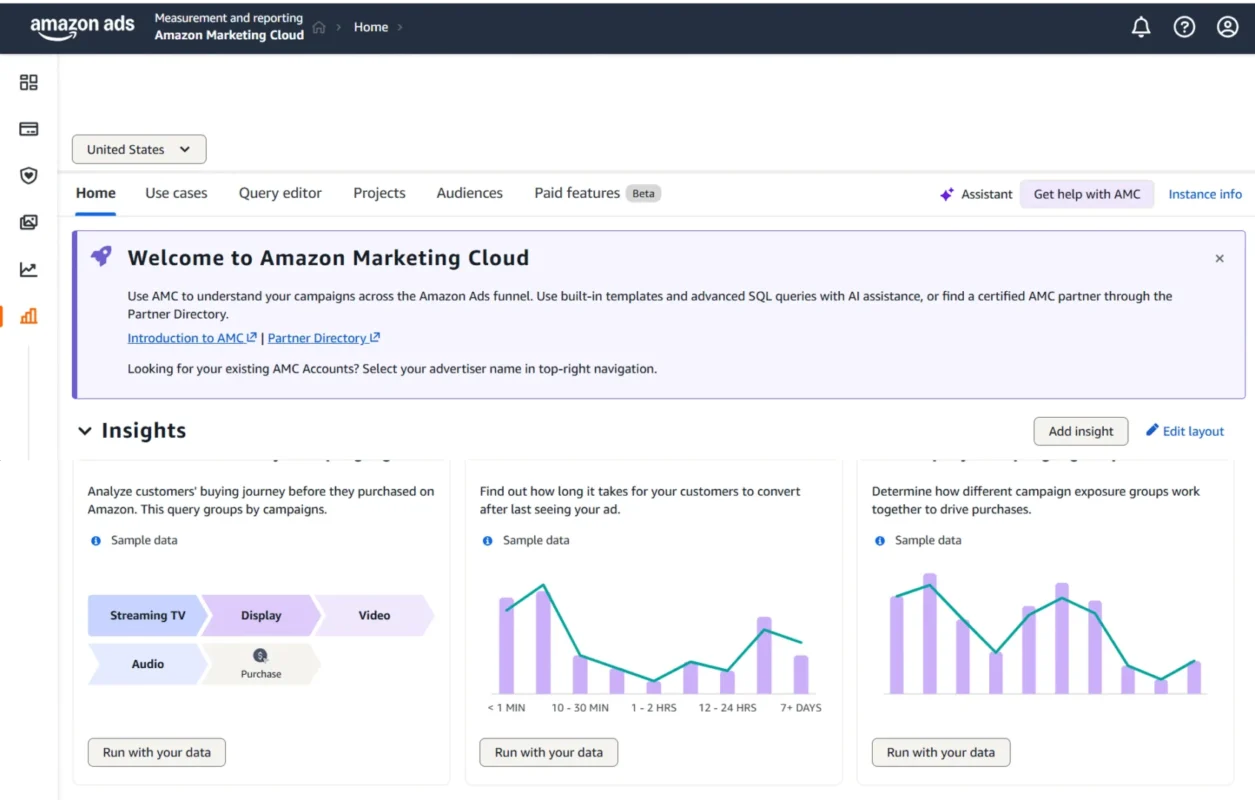
In plain terms: Amazon Marketing Cloud is the place where you can finally answer questions that have always been out of reach, like “How many touchpoints does it take before someone buys?” or “Which ads actually drive long-term brand growth instead of just a quick click?”
Key Features of Amazon AMC
1. Custom Analytics
Instead of relying on pre-built reports, you can design queries that match your specific questions. For example, you might want to measure how Sponsored Brands ads influence repeat purchases or whether DSP video campaigns work better when paired with Sponsored Products.
2. Pseudonymized data
Shopper identities are never exposed. Data is processed in a way that hides personal details, which means insights are available without risking compliance or privacy.
3. Aggregate outputs only
Amazon AMC won’t give you a list of individual shoppers. What you receive are group-level trends and behaviors (e.g., “20% of shoppers exposed to streaming TV ads later purchased within 30 days”).
4. Audience insights
Amazon Marketing Cloud highlights how different audiences overlap or differ. For instance, you could see how buyers of pet food overlap with Prime Video viewers of a popular dog documentary, or whether cart abandoners respond better to display ads versus video.
2025 Update
Originally, Amazon AMC was an exclusive tool for DSP advertisers, accessible only to larger brands with programmatic budgets. That’s changed. As of 2025, Sponsored Ads advertisers can now access AMC directly within the Ads Console. This shift of AMC for sponsored ads matters because it lowers the barrier for entry: mid-market and even smaller brands that only run Sponsored Products or Sponsored Brands campaigns can start experimenting with advanced analytics without needing DSP.
In short, Amazon Marketing Cloud has moved from a niche enterprise tool to a mainstream analytics platform inside Amazon’s advertising ecosystem.
How Amazon Marketing Cloud Works
To understand the value of Amazon Marketing Cloud, it helps to look under the hood. Amazon AMC isn’t just another dashboard, it’s a structured environment with specific inputs, rules, and tools designed for both flexibility and privacy.
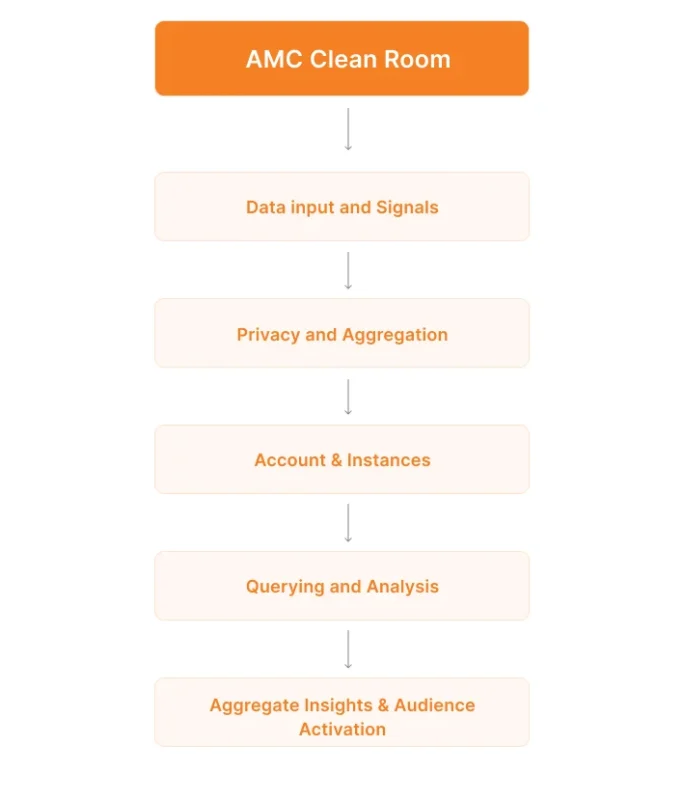
1. Data Inputs & Signals
Amazon Marketing Cloud (AMC) is only as powerful as the data you feed into it, and it pulls from two main sources:
1. Amazon Ads signals
This includes impressions, clicks, and conversions from across the Amazon advertising ecosystem: DSP display ads, Sponsored Products, Sponsored Brands, Sponsored Display, and even Streaming TV, audio, and video placements. Together, these signals map the full path from awareness to conversion. For example, AMC can show how many shoppers saw a Sponsored Brand video before clicking a Sponsored Product ad and eventually purchasing.
2. Advertiser signals
Brands aren’t limited to Amazon’s data. They can also bring in their own information, such as direct-to-consumer sales, CRM records, or product catalog mappings. This opens the door to connecting Amazon campaigns with broader business outcomes, like how Amazon ads influence repeat purchases on a D2C website.
3. Joinable fields
To connect different datasets without compromising privacy, AMC uses pseudonymized identifiers. These include hashed emails, phone numbers, or ASINs. In practice, this means you can link your CRM database with Amazon’s ad signals to see high-level relationships, without ever exposing personal shopper information.
2. Privacy & Aggregation
Amazon Marketing Cloud is designed with a “privacy-first” foundation. Every piece of shopper data is pseudonymized from the start. That means individual-level details are hidden, and you can only work with aggregated outputs.
On top of that, aggregation thresholds ensure that no report exposes data from too few users. For instance, if only five shoppers clicked a certain ad, Amazon AMC won’t show the result until the sample size is large enough to protect identities. And because no raw event-level data can leave the clean room, you can be confident that privacy rules are always enforced.
3. Account & Instances
Access to Amazon Marketing Cloud is structured in layers:
- Account: This is the umbrella for your organization. Think of it as the main folder under which everything else lives.
- Instances: Within each account, you can have separate “clean rooms” called instances. Each instance is dedicated to a specific advertiser or purpose.
- Standard Instance: A brand-specific environment where you run queries on your own campaigns.
- Sandbox Instance: A training ground with synthetic data for testing and learning without affecting live results.
- Collaboration Instance: Built for situations where advertisers want to combine AMC with AWS Clean Rooms, making it possible to analyze data alongside retail partners or other collaborators.
This structure allows advertisers to keep projects separate, while still managing them under one organizational account.
4. Data Retention in Amazon Marketing Cloud
When you first set up Amazon Marketing Cloud, Amazon provides 13 months of backfilled campaign data so you have enough history to analyze trends right away. From there, a rolling 13-month window is maintained.
For example, if you’re in March 2025, you’ll be able to analyze data going back to February 2024. This is particularly useful for seasonal brands who want to compare this year’s holiday campaigns against last year’s.
5. Querying & Analysis
The cornerstone of Amazon Marketing Cloud is AMC-SQL, a custom query language built specifically for analyzing Amazon Ads data. Skilled analysts can write complex queries to uncover detailed patterns like how frequency of exposure affects new-to-brand purchases.
But AMC isn’t limited to technical users. Amazon also provides:
- Pre-built templates for common questions (e.g., path-to-conversion, audience overlap).
- AI-assisted query builders that help non-technical users set up queries without writing code.
One limitation to note is that queries run on a per-instance basis. You can’t run a single query across multiple advertiser instances at once, which means analysis remains siloed to the specific dataset you’re working with.
Use Cases for Campaign Analytics
One of the biggest advantages of Amazon Marketing Cloud is that it answers questions traditional dashboards can’t. Instead of just seeing “clicks” or “sales,” AMC helps you understand the why behind performance. Here are some of the most common ways brands use AMC for campaign analytics:
1. Path-to-Conversion Analysis
Most Amazon reporting treats conversions as if they happened right after one click. In reality, shoppers often engage with multiple ads before buying. AMC allows you to see the full journey, from the first impression to the final purchase.
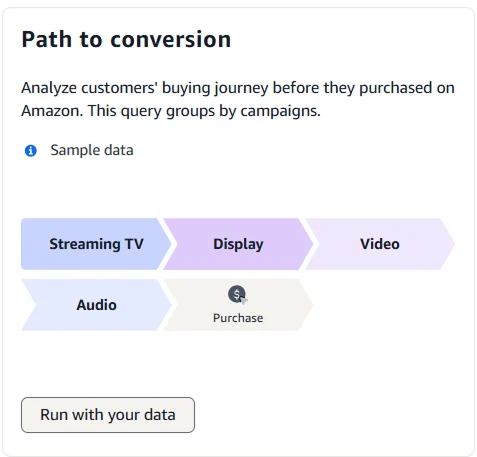
2. Frequency Distribution & Optimal Frequency
Ad fatigue is a real risk. Too few impressions and your ads don’t register; too many and you waste the budget. AMC lets you examine how often shoppers saw your ads before converting and where the curve flattens.
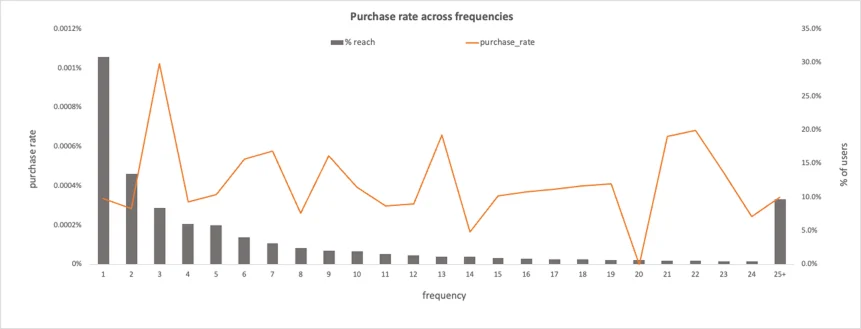
3. Audience Penetration & Overlap
AMC can measure how much of your target audience you’ve actually reached, and how those groups overlap with others. For example, you may discover that your Sponsored Brands campaign is reaching 60% of high-value repeat buyers, but your DSP retargeting ads are only reaching 25% of them. That signals a gap where you could improve targeting.
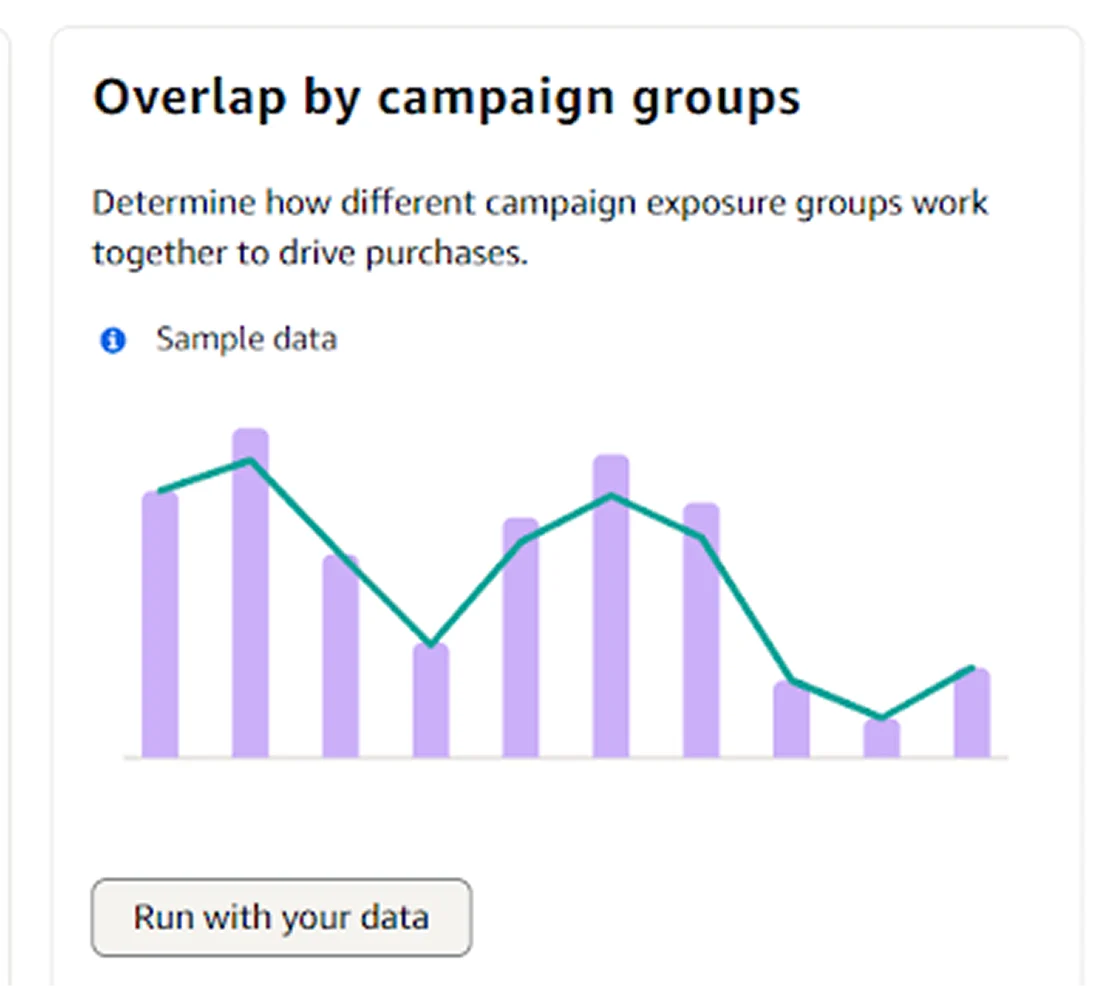
Overlap reports also reveal unexpected affinities. For instance, AMC might show that buyers of dog food also have high overlap with pet grooming categories, guiding cross-sell campaigns.
4. Media Mix Optimization in Amazon Marketing Cloud
Different ad formats serve different purposes. DSP display might build awareness, while Sponsored Products capture intent. AMC helps you see how the mix of ad types contributes to conversions as a whole.
5. Shopping Journey Across Channels
Shoppers don’t interact with Amazon ads in isolation. They move between DSP, Sponsored Ads, video, audio, and even external touchpoints. AMC shows you how these interactions combine across channels.
Amazon Marketing Cloud for Brand Strategy
While Amazon AMC is often positioned as a campaign analytics tool, its real power emerges when you step back and use it to guide brand-level decisions. Instead of asking, “Which ad drove sales yesterday?” you start asking, “How do all of my campaigns and products work together to grow the brand over time?”
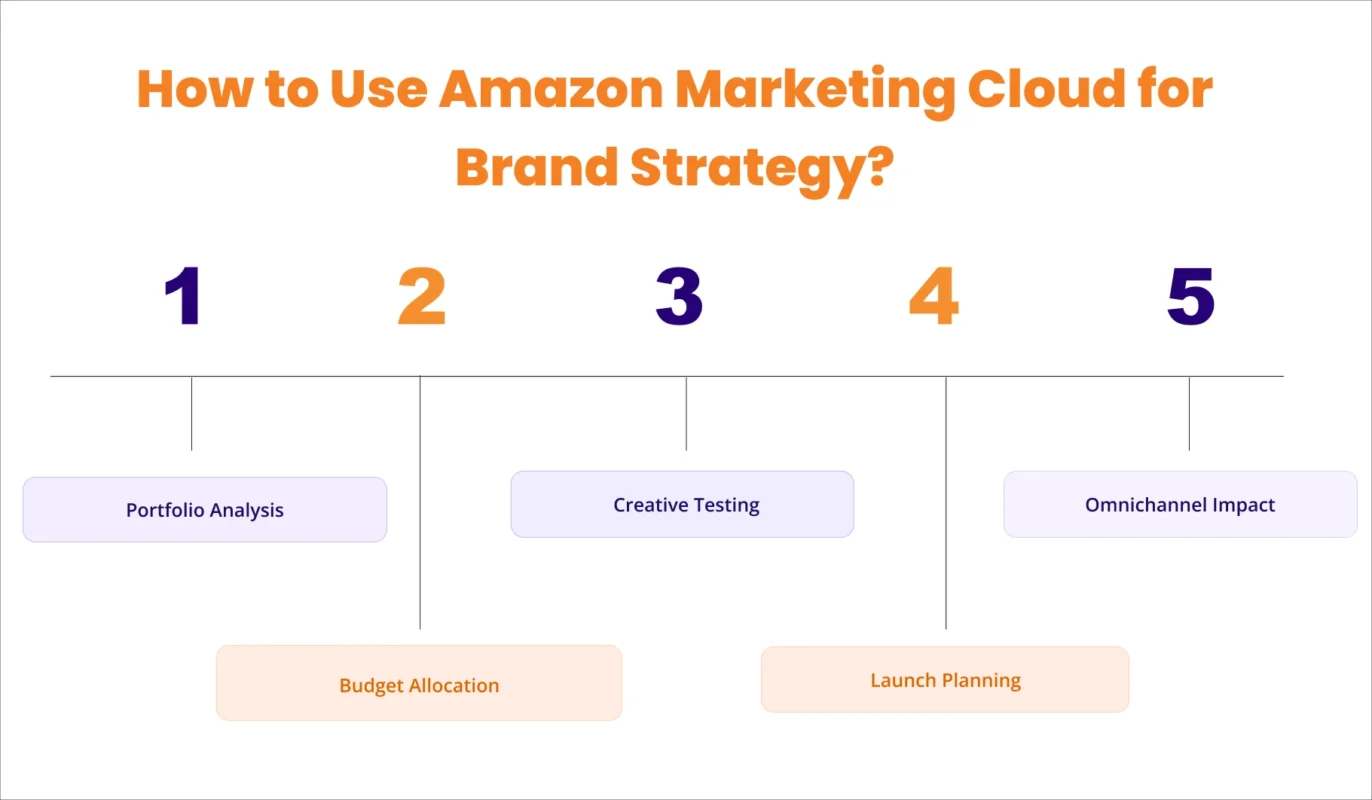
Here are some of the ways Amazon Marketing Cloud informs bigger-picture strategy:
1. Portfolio Analysis: Gateway ASINs & Halo Effects
Not every product in your catalog plays the same role. Some listings act as gateway ASINs as they bring shoppers into your brand for the first time and trigger follow-up purchases in related categories.
For example, a skincare company may see that shoppers who first purchase a low-priced facial cleanser later buy premium serums and moisturizers. Amazon Marketing Cloud can highlight these halo effects by mapping post-purchase behavior, giving you the evidence to double down on ads for gateway products.
2. Budget Allocation: Funnel Balancing
Marketers often struggle with where to place money. Should it go to upper-funnel awareness or lower-funnel conversion ads? Amazon Marketing Cloud provides clarity by showing how different touchpoints contribute at each stage of the funnel.
For example, a sports nutrition brand might learn that upper-funnel DSP video campaigns are critical for driving new-to-brand traffic, even if they don’t immediately convert. Meanwhile, Sponsored Products are best for closing the sale. With AMC, the brand can balance budgets between both rather than over-investing in the bottom of the funnel.
3. Creative Testing: Measuring What Actually Lifts NTB
Testing creatives isn’t just about CTRs. Amazon Marketing Cloud allows brands to measure which ad messages actually increase new-to-brand (NTB) conversions. For example, a pet food company could run two Sponsored Brand video creatives: one focused on nutrition, the other on emotional storytelling. AMC can reveal that the nutrition-focused message led to a higher percentage of first-time buyers, guiding future creative development.
4. Launch Planning: Sequencing Ads for New Products
Launching on Amazon is all about momentum. Amazon AMC helps plan the sequencing of Sponsored Ads and DSP campaigns to maximize visibility and conversion during a launch window. For example, for a new beverage flavor, a brand could start with DSP awareness ads to build recognition, then shift into Sponsored Products to capture search-driven demand. AMC tracks how these phases connect, ensuring spend is working in the right order.
5. Omnichannel Impact: Connecting Amazon & D2C
AMC doesn’t stop at Amazon-only results. By feeding in your D2C or CRM data, you can understand the true cross-channel impact of Amazon Ads. For example, a consumer electronics brand could see that shoppers exposed to Amazon DSP display ads were more likely to later purchase on the brand’s own Shopify site. These insights justify Amazon spend, even if conversions don’t always happen directly on Amazon.
Who Can Use AMC & How to Get Access
When AMC first launched, it was reserved for enterprise advertisers running DSP campaigns with large budgets. That made it feel like a walled garden; powerful, but out of reach for many brands. As of 2025, that barrier has come down. Now, a wide spectrum of advertisers can tap into AMC’s capabilities, whether they’re running multi-million-dollar DSP strategies or focusing solely on Sponsored Ads.
1. Direct Access for Sponsored Ads Advertisers
The most significant update is that Sponsored Ads advertisers now receive an AMC instance instantly through the Ads Console. No separate application or technical onboarding is required. This democratization means that smaller and mid-market brands, who may never have touched DSP, can finally experiment with AMC’s analytics tools.
2. Enterprise Access for Multi-Brand & DSP Users
For advertisers managing complex portfolios or running large DSP campaigns, AMC access still follows a more structured route. Enterprise users typically apply through their Amazon AdTech account executives (AEs). These setups often involve:
- Multiple instances for different brands or regions.
- Admin-level controls for managing permissions.
- Integration with AWS Clean Rooms for collaborative analysis with retail partners.
Skill Levels: Who Benefits Most from Amazon Marketing Cloud (AMC)?
AMC can be used by teams at different stages of analytics maturity:
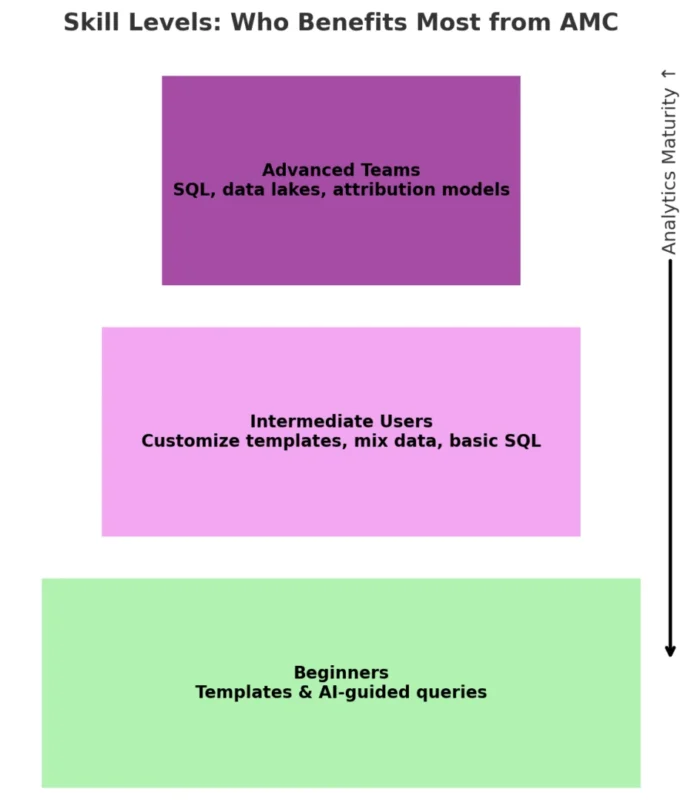
1. Beginners:
Marketers without technical training can start with pre-built templates and Amazon’s AI-guided query tools. These make it possible to answer common questions such as audience overlap or campaign frequency without touching a line of code.
2. Intermediate users:
Data-savvy marketers can begin customizing templates, combining advertiser data with Amazon signals, and experimenting with basic SQL queries.
3. Advanced teams:
Data science or analytics teams can write full SQL queries, integrate AMC with internal data lakes, and design custom attribution models. These advanced users extract the maximum value, but they also require the most resources and expertise.
Benefits vs Limitations
Like any advanced analytics tool, AMC comes with both strengths and trade-offs. For many advertisers, it unlocks a level of visibility and control that simply isn’t possible through standard Amazon Ads reporting. At the same time, it’s not a perfect fit for every brand, especially those with limited budgets, smaller datasets, or lean teams. Understanding both sides helps set the right expectations before investing time and resources into AMC.
Benefits:
- Built-in privacy compliance: AMC was designed with a privacy-first foundation, ensuring all data is pseudonymized and aggregated.
- Broader view of campaign effectiveness: Unlike Ads Console or DSP reports that work in silos, AMC stitches together multiple touchpoints for a holistic picture.
- Unique insights into audience overlap and penetration: Brands can understand how different shopper groups intersect, revealing untapped opportunities.
- Ability to activate audiences directly in campaigns: Insights aren’t just theoretical but advertisers can build and push audiences straight into DSP or Sponsored Display campaigns.
Limitations:
- Aggregation thresholds. Smaller advertisers may not see detailed results because AMC suppresses outputs when sample sizes are too low.
- Data refresh lag. AMC is not real-time; it operates on a delayed refresh cycle, which may limit fast-turn optimization.
- SQL requirement for advanced use. While templates cover basics, deeper analysis still requires SQL knowledge or technical support.
- Premium datasets may carry extra costs. Add-ons like Audience Segment Insights provide richer data, but they increase spend.
AMC vs Alternatives
AMC isn’t the only way to measure Amazon advertising performance, but it stands apart in terms of depth and flexibility. Most advertisers begin with the Ads Console or DSP reporting, and some layer in third-party analytics tools for multi-platform tracking.
The difference is that AMC is purpose-built for strategic analysis so it goes beyond tactical metrics like ACoS or CTR and gives brands a full-funnel, cross-channel perspective. That said, it also demands more skill, data maturity, and scale than the simpler tools.
| Tool | Strengths | Weaknesses |
| AMC | Strategic, cross-channel insights | Requires skill & scale |
| Ads Console | Simple, tactical reports | Limited scope |
| DSP Reporting | Granular on DSP only | Doesn’t cover Sponsored Ads |
| 3rd-party Tools | Multi-platform View | Limited access to Amazon data |
Is AMC Useful for Your Brand?
Not every advertiser will benefit equally from Amazon Marketing Cloud. The tool is incredibly powerful, but it also requires a certain level of spend, data maturity, and team capability to unlock its full potential. Before diving in, it’s worth stepping back and evaluating whether AMC aligns with your brand’s current stage and long-term goals.
Step 1: The AMC Checklist
Ask yourself these questions before diving in:
- Do you run Sponsored Ads or DSP campaigns at scale?
AMC now offers direct access for Sponsored Ads advertisers, but its real power comes when you have enough campaign volume to meet aggregation thresholds.
- Do you need insights beyond Ads Console reporting?
If you want to understand path-to-conversion, frequency impact, or new-to-brand lift, AMC is the right tool. If you only need tactical ACOS/ROAS data, the Ads Console may be enough.
- Do you have the right skills and bandwidth?
Basic: You can get started with AMC’s no-code templates and AI-assisted queries.
Advanced: To see deeper brand insights, you’ll need SQL capability or an analyst to interpret data.
- Are you using AMC insights to shape strategy, not just validate results?
The brands that get the most value from AMC use it to inform portfolio planning, budget allocation, and creative direction not just to track clicks.
Step 2: Scenarios by Brand Size
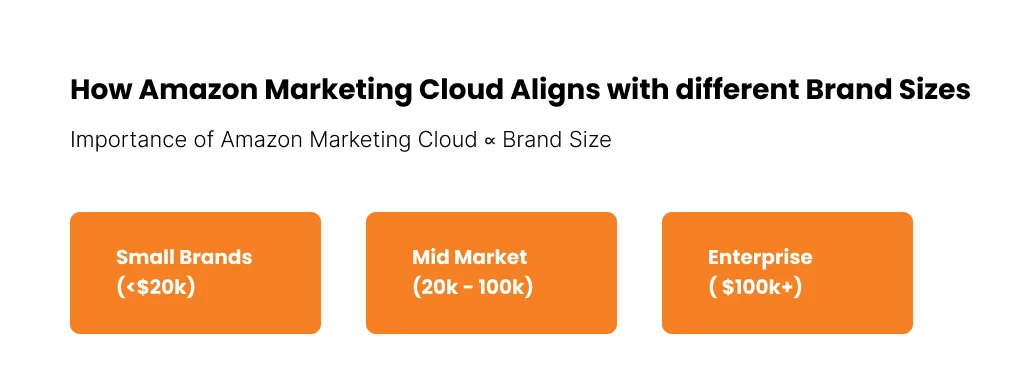
Small Brands (Ad spend <$20k/month)
- Access: Direct via Ads Console.
- Likely insights: Reach/frequency basics, NTB % from templates.
- Limitations: Data thresholds may suppress detailed reports.
- Verdict: Use AMC to explore and learn, but don’t expect transformative insights at this stage.
Mid-Market Brands ($20k–$100k/month)
- Access: Sponsored Ads + some DSP.
- Likely insights: Path-to-conversion, media mix impact, audience overlap.
- Benefits: Can link AMC ads insights directly to budget allocation and creative testing.
- Verdict: Strong fit. AMC helps go up from tactical optimization to strategic planning.
Enterprise Brands ($100k+/month, active DSP + Sponsored Ads)
- Access: Full AMC suite with SQL flexibility.
- Likely insights: Incrementality proxies, cross-channel ROI, portfolio strategy (gateway/halo ASINs).
- Benefits: Complete view of customer journeys and long-term NTB growth drivers.
- Verdict: Essential. AMC ad becomes a cornerstone for brand strategy and market leadership.
Step 3: Pilot Plan for AMC
If you’re unsure, run a 90-day AMC pilot before committing resources.
- Start simple: Use no-code templates for reach/frequency, NTB, and path-to-conversion reports.
- Measure what matters: Compare Amazon Marketing Cloud insights with existing Ads Console/DSP reports and analyze what new patterns do you see?
- Translate insights into action: Adjust budget split, tweak frequency caps, or test creative variants based on findings.
- Evaluate ROI: After 90 days, ask: Did AMC ads insights change our decision-making, or just validate what we already knew?
- Scale up if valuable: Move into SQL queries, upload first-party data, and integrate AMC into quarterly strategy planning.
The Future of AMC
Amazon Marketing Cloud is still evolving, and Amazon is investing heavily to make it more accessible and impactful. In the coming years, expect several shifts:
- More ready-to-use templates. Pre-built queries will expand beyond basics, giving non-technical users faster access to insights without needing SQL.
- Smarter AI-driven querying. Natural-language questions will increasingly translate into structured insights, reducing reliance on technical analysts.
- Deeper cross-channel integrations. AMC will connect more tightly with AWS Clean Rooms, BI tools, and external media platforms, positioning it as a hub for omnichannel measurement.
- Mainstream adoption. With Sponsored Ads access now standard, AMC is set to become the default analytics environment for serious Amazon advertisers.
In short, AMC is moving from a specialist tool to a strategic must-have, and brands that build capability now will gain an edge as it becomes industry standard.
Conclusion
Amazon Marketing Cloud started as a niche tool for DSP users, but it’s now open to Sponsored Ads advertisers as well. While it’s not one-size-fits-all, AMC can be transformative for brands that have the scale, data maturity, and goals to use it strategically.
Concisely, AMC isn’t just another reporting dashboard, it’s a decision-making engine. For brands ready to move from tactical optimizations to long-term strategy, AMC is where the real answers live.
FAQs
Q1. Is Amazon Marketing Cloud (AMC) free to use?
Access to a basic AMC instance is free for Sponsored Ads and DSP advertisers, but certain premium datasets (like Audience Segment Insights) may come with additional costs.
Q2. Do I need to know SQL to use AMC?
Not necessarily. Amazon provides pre-built templates and AI-assisted query builders for beginners. However, SQL knowledge unlocks the full power of AMC, especially for custom or complex analysis.
Q3. How is AMC different from the Amazon Ads Console?
The Ads Console provides tactical, campaign-level metrics like clicks, spend, and ACoS. AMC, on the other hand, delivers strategic, cross-channel insights such as path-to-conversion, frequency analysis, and audience overlap.
Q4. Can smaller advertisers benefit from AMC?
Yes, but with limits. Smaller brands can use templates to explore audience overlap or simple campaign insights. However, due to aggregation thresholds and smaller datasets, the depth of insights will be less than for higher-spend advertisers.
Q5. How does AMC help my brand grow long term?
AMC enables brands to go beyond campaign performance and answer bigger questions—like which products serve as entry points (gateway ASINs), how to balance funnel budgets, and how Amazon Ads influence sales across D2C or other channels.


